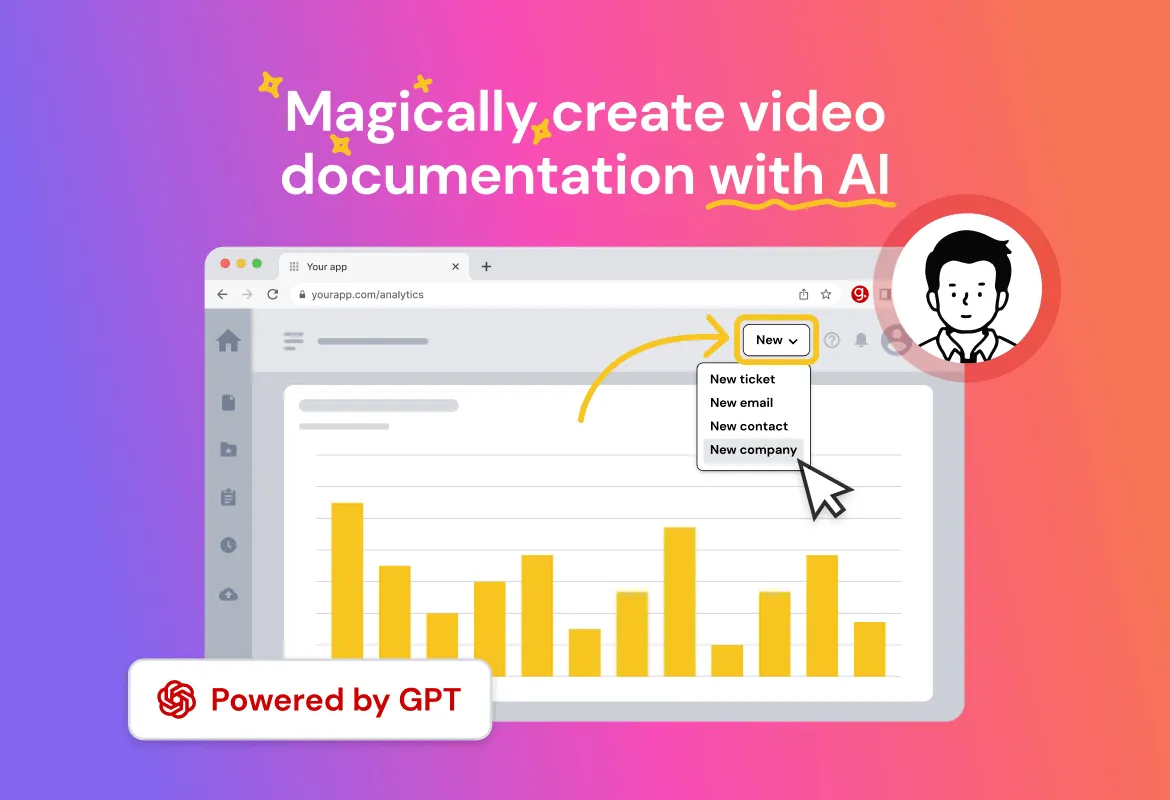How to Create Good Process Documentation
Learn how to create good process documentation. Empower your team, minimize errors, and streamline workflows within your organization.
Published April 23, 2024.

Efficient companies run on great processes. But often these processes are fragmented across teams, poorly captured, or not even documented.
Let’s face it: creating documentation takes time, but it’s time you can’t afford to sacrifice if you want your teams to work efficiently. Below, we’ll cover the steps you need to take to improve your work, followed by robust process documentation without sacrificing heaps of your time.
What Is Process Documentation, and Why Does It Matter?
Think of process documentation as a detailed roadmap for completing specific organizational tasks. It systematically records the steps involved in a workflow, capturing the essence of these processes in real-time. This translates into a comprehensive guide that can take various forms, like policies, tutorials, and flowcharts.
» Discover how to write process documentation
How to Create Good Process Documentation in 7 Steps
Creating good process documentation goes beyond simply listing steps in a workflow. Here's how you can craft user-friendly process documentation:
1. Create Clear Step-By-Step Descriptions
Every process needs a clear pathway or workflow. By naming each step, you provide an easy-to-follow guideline for anyone trying to follow along. Use action verbs to clearly and concisely outline each step.
Make sure steps are easy to replicate, improve, or modify as needed. Use simple language and avoid jargon that may confuse new team members.
Pro tip: Test the clarity of your steps with individuals unfamiliar with the process to identify any areas needing simplification.
2. Define Roles and Responsibilities
List the people involved at each step in the process, not just those accountable, but those who play a role in decision making. This eliminates ambiguity and ensures clear ownership of tasks. You can map this using RACI charts (Responsible, Accountable, Consulted, Informed) which represent roles and responsibilities within the process visually.
3. Inputs and Outputs
Clearly define the information or materials required to initiate the process (inputs) and the expected outcome (outputs). This sets expectations and ensures everyone is working towards the same goal.
Example: For a process like "Client Onboarding," inputs might include the signed client contract and completed client information form, while the output would be a fully activated client account.
4. Required Tools and Resources
Specify the tools and resources needed to complete each process step. This eliminates roadblocks and ensures team members have everything they need to do the job efficiently. Include standard productivity tools—project management software, communication platforms, etc. Ideally, your process documentation should integrate seamlessly with these existing tools.
» Explore the importance of documentation and why it's the key to success
5. Timelines and Milestones
Establish clear deadlines and milestones for each step to ensure timely process completion. This promotes accountability and keeps projects on track. Visual timelines represent the overall process flow and individual step durations.
6. Accessibility
Ensure documentation is formatted for easy reading and accessibility to users with disabilities. This may include using clear fonts, appropriate color contrast, and alternative image text descriptions.
» Check out these tips for taking the pain out of process documentation
7. Visual Aids
Incorporate flowcharts, diagrams, and screenshots to enhance understanding and user-friendliness. Visuals can break down complex processes into easily digestible chunks and cater to different learning styles.
8. Version Control
Implement a version control system to track changes made to the documentation over time. This allows you to revert to previous versions if necessary and ensures everyone works with the most up-to-date information.
Create Instant Video Documentation With AI
Some solutions like guidde allow you to capture on-screen workflows and automatically generate narrated video instructions, reducing the time and effort required to create high-quality documentation.
Benefits of Process Documentation
By creating process documentation, you gain several advantages:
- Improved Consistency and Efficiency: Ensure standardized operations and minimize confusion through clear step-by-step instructions. Everyone on the team is on the same page, leading to a smoother workflow and fewer errors.
- Reduced Errors: Minimize process inconsistencies and errors by providing a central knowledge base. Clear documentation eliminates guesswork and ensures everyone is following the same established procedures.
- Enhanced Onboarding and Training: New hires can learn and become productive team members faster. A clear reference point guiding them reduces reliance on colleagues for every question.
- Preserved Knowledge: Capture and retain valuable institutional knowledge for easy access and future reference. Experienced team members' expertise is documented and readily available, even if they move on to other roles. This prevents knowledge gaps and ensures continuity within your organization.
Pro tip: To overcome challenges in creating and maintaining process documentation, involve subject matter experts regularly for accuracy updates. Break information into digestible sections and conduct user testing for enhanced user engagement.
Best Practices for Process Documentation
Crafting user-friendly process documentation empowers teams and optimizes workflows. Here are key principles gleaned from industry experts:
Structure and Clarity: Organize information logically for easy comprehension. This includes a consistent format, clear headings, and a recommended structure.
Visual Appeal: Enhance understanding, especially for complex processes, by incorporating visuals like flowcharts, diagrams, and screenshots.
Integration and Collaboration: Utilize tools that facilitate collaboration among team members during creation. Consider solutions that seamlessly integrate with existing workflows and knowledge management systems.
Centralized Storage: Maintain a central location, such as a knowledge base platform, for storing and accessing process documentation to promote consistency and easy access.
The Power of Clear Process Documentation
Clear and comprehensive process documentation is an investment in your organization's success. It empowers teams, minimizes errors, and streamlines operations, paving the way for a more efficient and productive work environment.
Solutions like guidde make the documentation process quick and easy. This AI-powered tool takes your guided video and instantly breaks it down into clearly annotated documentation, which you can quickly share with all people involved. This means you don't have to spend loads of time marking up screenshots or detailing steps yourself
